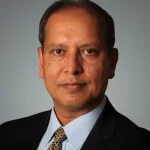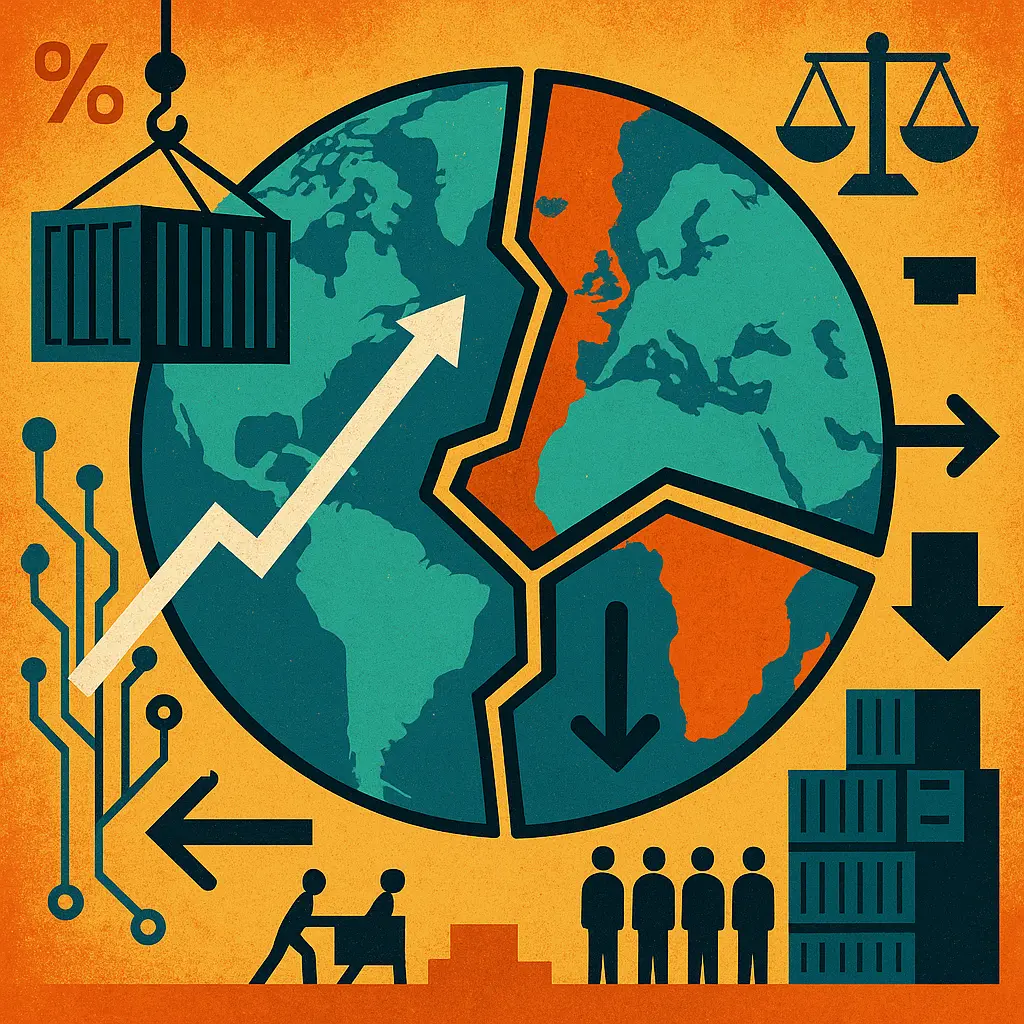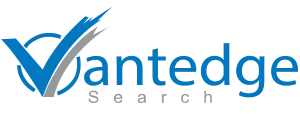View From The Top

Rajesh Khanna,
President,
Vantedge Search
This month’s edition captures a truth that every board and leadership team is confronting: global volatility is no longer a temporary state—it’s the operating climate. Tariffs, regulatory friction, and shifting supply chains are not disruptions to wait out; they are signals to adapt, redesign, and lead differently. As the cover story reminds us, the winners will be those who combine decisiveness with cultural fluency and operational discipline, ensuring their organizations remain resilient while continuing to expand with purpose.
What this means for leadership is clear: the profile of the modern executive is changing. Financial acumen and operational track records are table stakes. What distinguishes the next generation of leaders is adaptability across borders, fluency with technology-driven delivery, and a deep commitment to embedding culture and credibility locally. At Vantedge Search, we see this shift not as a challenge, but as an opportunity. Our role is to partner with boards and CEOs in identifying and securing the leaders who will not just manage volatility, but convert it into long-term value creation.
Beyond Tariffs: Expansion in a Fractured Global Economy

The rules of global expansion are being rewritten—by trade volatility, regulatory friction, and rising local expectations. What once felt like a linear growth play—replicate, scale, standardize—now requires something far more nuanced: a blend of decisiveness, cultural fluency, and operational discipline.
For CEOs navigating geographic expansion, the real risk is not in moving too fast. It lies in standing still.
The End of “Wait and See”
Many leadership teams have been conditioned to pause when the path forward seems unclear, waiting for the next trade policy, next administration, or next round of clarity. But the new global reality demands the opposite: movement, adaptation, and structural resilience.
Tariffs, for example, are not just policy quirks; they are catalysts. They expose fragilities in sourcing models, delivery systems, and geographic dependencies. And they reward companies that respond by rethinking, not retreating.
Forward-looking organizations are treating this disruption not as a detour, but as an accelerator. They’re shifting from labor-cost arbitrage to technology arbitrage, replacing outdated outsourcing models with cloud-enabled, AI-supported operations. They’re not reshoring in the traditional sense; they’re re-architecting work to be distributed, intelligent, and locally accountable.
Structured Agility: The New Operating Mandate
The most resilient expansion models today rest on a deceptively simple idea: systematic prioritization.
This doesn’t mean more meetings or longer decks. It means creating daily front-line clarity. Some of the most operationally effective leaders are rethinking how they start the day, distilling strategic direction into a handful of must-do actions tied to growth, culture, and quality.
These daily rituals become the connective tissue across a multi-location footprint. They translate global intent into local execution. And, importantly, they empower teams to adapt, without drifting off-mission.
What works in practice is a core-periphery model: hold firm to brand standards, training, and values (the “core”), while flexing on offerings, messaging, and engagement strategies that are context-specific (the “periphery”). Done well, this allows brands to feel both consistent and local—trusted, not transplanted.
Culture Isn’t a Soft Issue—It’s a Strategic One
One of the most overlooked elements of expansion in volatile markets? Cultural relevance. Leaders often underestimate how much local credibility fuels brand success, not just with customers, but with talent.
Organizations that treat cultural authenticity as a priority—not a side effect—are seeing returns in retention, loyalty, and operational alignment. This means hiring local, celebrating community, and adapting offerings without diluting the brand.
And as operations digitize, this local anchor becomes even more important. AI and automation can scale consistency. But only human insight can embed relevance. The companies getting this right are those that pair systems with storytelling, and platforms with people.

Executive Talent for the Expansion Era
As growth strategies evolve, so must leadership profiles. Modern expansion demands more than financial acumen—it requires:
- Cross-border adaptability
- Comfort with tech-driven delivery
- Fluency in ambiguity
- Commitment to community-building
It’s no longer enough to plug in operators with a strong P&L record. Organizations need strategic integrators, leaders who can work across cultures, leverage digital systems, and still deliver on-the-ground impact.
Bottom Line: The global landscape will remain volatile. The question is not whether to expand, but how. The winners will be those who act with clarity, lead with purpose, and build organizations designed not just to grow, but to evolve.
Source:
For more information on Vantedge Search, please contact us. We look forward to hearing from you.
Expert's Corner –
What's Trending?
Insights from Industry Leaders on Thriving Amid Global Trade Shocks
Global trade tensions, tariffs, and shifting supply chains are increasingly becoming the new operating climate. The leaders thriving in this environment share a common approach: they treat shocks not as setbacks to be endured, but as catalysts to rewire strategy. Whether it’s recalibrating cost structures without eroding customer trust, doubling down on long-term resource bets, or reshaping manufacturing footprints for a more regionalized future, the emphasis is the same: agility over reaction, foresight over fear.

Agility Over Reaction: How GM’s CFO Paul Jacobson Is Redefining Strategic Resilience
For General Motors CFO Paul Jacobson, the second quarter of 2025 delivered a hard lesson in global volatility: a $1.1 billion tariff-related hit and a 35% drop in net income. But Jacobson’s response wasn’t retreat—it was recalibration.
Speaking to investors, Jacobson outlined GM’s plan to offset at least 30% of the company’s projected $4–5 billion annual tariff exposure through a combination of supply chain shifts, targeted cost initiatives, and careful pricing management. Crucially, he emphasized that GM would not pass these costs on to consumers in the near term, choosing instead to preserve brand trust and demand through disciplined operational control.
What sets GM apart, according to Jacobson, is its organizational agility: the ability to move quickly in response to trade policy shifts, regulatory changes, and evolving consumer demand. Rather than viewing tariffs as external shocks, GM is using them as pressure points to accelerate production realignment, including a $4 billion investment in new U.S. assembly plants that will reduce reliance on foreign inputs long-term.
The company’s performance speaks to this strategy: despite the tariff headwinds, GM beat Wall Street expectations on revenue, earnings, and EBIT. Jacobson credits this resilience to the finance function’s ability to pivot rapidly—an increasingly essential capability for CFOs navigating today’s high-volatility global economy.
In his words, “Our agility and responsiveness… remain key strengths that set us apart.” It’s a mindset that’s fast becoming the standard for leadership in an era where “wait-and-see” is no longer an option.

Volvo CEO, Håkan Samuelsson: Regionalization Is No Longer Optional
Reappointed to lead Volvo Cars through a turbulent period, CEO Håkan Samuelsson doesn’t mince words: “To think that you can produce one type of car in one place and send it across the world is a thing of the past.”
He emphasizes a shift toward regional manufacturing hubs as a strategic imperative in the face of new U.S. auto tariffs. The company plans to ramp up production at its Charleston, South Carolina plant to reduce exposure to the newly imposed 25% import duty.
While Volvo is already well positioned in Europe and China, Samuelsson acknowledges the U.S. as a relative weakness and committed to correcting that gap. A key part of his approach will be identifying a high-volume vehicle suited for U.S. production and demand.
Samuelsson’s broader turnaround vision focuses on three strategic pillars: electrification, profitability, and regionalization. While detailed plans are still in development, his early message is clear: Volvo’s future won’t be built on centralized production and global shipping. Instead, it will rest on flexible, localized manufacturing that aligns with evolving trade realities.
Source: Volvo Cars’ new CEO vows to produce more cars in US | Reuters
Tariffs Can’t Shake Long-Term Strategy, Says Barrick Gold CEO, Mark Bristow
For Barrick Gold CEO Mark Bristow, the looming 50% U.S. tariff on imported copper is just another headline in an increasingly unstable market. Speaking in Zambia, Bristow acknowledged the short-term shock—U.S. copper futures spiked to an all-time high—but emphasized that copper’s long-term demand story remains intact.
“We’re seeing a supply shortage, growing demand from data centers and clean energy, and industrialization in emerging markets,” Bristow said. “Everyone agrees copper demand is outpacing supply.”
Rather than scale back, Barrick is leaning in. The company is executing a $2 billion expansion of its Lumwana mine in Zambia to double annual copper output by 2028 and extend the mine’s life to 2057. Bristow positioned this as a preemptive move, investing ahead of tightening supply conditions while others pursue marginal growth.
His view is clear: short-term volatility is inevitable, but strategy must serve the long arc of value creation.
Source: Copper’s positive, long-term trajectory unchanged despite US tariff, Barrick CEO says | Reuters
Executive Movements:
Leadership Transitions & Strategic Pivots
CEO Movements
Harley-Davidson has appointed Artie Starrs as President and CEO, effective October 1, 2025. Starrs previously served as CEO of Topgolf, where he oversaw global expansion and a 50% revenue increase.
Linda Yaccarino, former CEO of X (formerly Twitter), has joined health tech firm eMed just weeks after exiting Elon Musk’s company. She will lead a new division focused on supporting patients using weight-management medications.
Jeff Sulzbach has been named CEO and Scout Executive of Northern Star Scouting, effective September 1. Returning to Minnesota, Sulzbach previously played a key role in major initiatives like Base Camp and the $25M “Shaping Tomorrow’s Leaders” campaign.
Six Flags has announced that CEO Richard A. Zimmerman will step down by the end of 2025. He will continue in the role until a successor is appointed to ensure a smooth leadership transition. The Board has initiated a formal search for the next CEO.
Kelly Services has named Chris Layden as its new president and CEO, effective Sept. 2, succeeding retiring CEO Peter Quigley. Layden, formerly COO at Prolink and a ManpowerGroup veteran, brings decades of staffing experience to lead Kelly’s next phase of growth.
Pepe Jeans London has appointed Rakesh Jallipally as CEO for India. He transitions from Flipkart, where he served as Vice President, bringing extensive leadership experience in retail and e-commerce.
President Donald Trump has called for Intel CEO Lip-Bu Tan to resign immediately, citing “highly conflicted” ties to Chinese firms, including $200M in investments linked to the Chinese military.
KPMG in India has reappointed Yezdi Nagporewalla as CEO for a second three-year term starting February 2027. His leadership has driven strong growth, client trust, and cultural transformation, and the firm aims to continue building momentum under his guidance.
US AI appointed Jamie Holcombe, former CIO and Chief AI Officer of the USPTO, as Vice President, recognizing his leadership in major federal IT transformations, cloud adoption, and AI innovation.
Lithia & Driveway’s Chief People Officer, Gary Glandon, will retire on December 31, 2025. Known for his pivotal role in HR strategy, Glandon’s successor will be announced as part of ongoing succession planning.
Procter & Gamble has appointed COO Shailesh Jejurikar as its next President and CEO, effective January 1, 2026, succeeding Jon Moeller, who will transition to Executive Chairman. Jejurikar has also been nominated for election to the Board this October.
UnitedHealth Group has appointed Wayne S. DeVeydt as its new CFO effective Sept. 2, 2025, succeeding John F. Rex, who will transition to a strategic advisor role. DeVeydt brings deep healthcare finance experience, including leadership roles at Bain Capital, Anthem, and Surgery Partners.
S&P Global appointed CARFAX CEO Bill Eager as President of S&P Global Mobility and CEO-designate of its planned standalone public company, effective August 15, 2025. He succeeds Edouard Tavernier, who will remain a strategic advisor through September.
PGA TOUR Superstore has named Troy Rice as its new CEO, effective Sept. 2, 2025. With 30+ years in retail leadership—including CEO roles at Total Wine & More and senior positions at The Home Depot—Rice succeeds Dick Sullivan, who becomes executive chairman.
Renault has appointed François Provost as CEO following Luca de Meo’s June departure to Gucci. A 23-year veteran and key architect of the “Renaultution” strategy, Provost will lead the company through EV competition and margin pressures with a focus on innovation and execution.
Everest Group has appointed Jill Beggs as Executive Vice President and CEO of Reinsurance, effective immediately. With over 30 years in risk management and a proven track record at Everest and Munich Re, Beggs will lead global reinsurance strategy and growth across all markets.
Subway named Jonathan Fitzpatrick as Chief Executive Officer, effective July 28, 2025. A seasoned leader with experience at Driven Brands and Burger King, Fitzpatrick brings a strong record in franchise growth and operational excellence to lead the global sandwich chain’s next chapter.
Debra Crew has exited her role as CEO of Diageo amid falling alcohol consumption, inflation-driven cutbacks, and global tariff challenges. CFO Nik Jhangiani will serve as interim CEO as the board begins a search for her successor.
Simon Trott has succeeded Jakob Stausholm as CEO of Rio Tinto, effective August 25, 2025. Previously Iron Ore Chief Executive, Trott brings 25 years of leadership across global commodities with a focus on safety, performance, and stakeholder relations.
CFO Movements
- PetMed Express CEO Sandra Campos and CFO Robyn D’Elia resign amid a whistleblower probe and Nasdaq compliance issues.
- Citizens Financial Group appoints Barclays exec Aunoy Banerjee as CFO, replacing John Woods, who heads to State Street.
- Ibotta named former VF Corp. finance chief Matt Puckett as its new CFO, effective August 25.
- FTI Consulting CFO Ajay Sabherwal to exit on September 12, with Paul Linton stepping in as interim CFO.
- Sonrava Health hires Judd Tirnauer, former CFO of California Pizza Kitchen and Backcountry, as its new finance chief.
- Cyngn promotes Natalie Russell, interim CFO since June, to full-time CFO of the autonomous tech company.
- Repay Holdings appoints Robert Houser, former Conduent group CFO, as its new finance chief starting September 8.
- dLocal names Guillermo Lopez Perez, former CFO of Featurespace and Tink, as permanent CFO.
CIO/CTO Movements
SpartanNash appoints Ed Rybicki as CIO and Brett Hoffman as CISO, aligning IT under CFO Jason Monaco in its newly combined Finance/IT/Strategy organization.
TERREPOWER appointed Richard Longsdorf as executive vice president and chief information officer, effective August 5.
Peloton appointed Corey Farrell as Chief Information Officer to lead its enterprise systems strategy and technology roadmap, bringing over 20 years of technology leadership experience.
Ball Corporation appointed Edmund “Ted” Doering as Chief Information Officer, succeeding the retiring Brian Gabbard, and reaffirmed its quarterly cash dividend of US $0.20 per share payable in September 2025.
Hinshaw appointed Tara Cook as new Chief Information Officer.
Southern Company appointed Hans Brown as Executive Vice President and Chief Information Technology Officer, effective July 31.
Insights: Inferring the why
The recent wave of CEO movements reveals deliberate strategic pivots in response to shifting market realities, technology adoption curves, and geopolitical complexity.
Key Insights:
- Succession planning is moving from reactive to anticipatory
Companies are no longer waiting for a leadership gap to emerge. Announcing CEO designates years in advance, or orchestrating smooth retirements with long handover periods, shows a shift toward minimizing transition risk. It reassures investors, employees, and partners that there’s a roadmap for leadership continuity. - Cross-industry talent flow is gaining momentum
Leaders are increasingly being hired from outside their current industry — a retail veteran into mobility, a tech leader into traditional manufacturing. This reflects a belief that operational models and customer strategies can benefit from proven playbooks in other sectors, particularly as digital and data capabilities become industry-agnostic. - Geopolitical pressure is shaping boardroom agendas
In some cases, leadership changes are happening under the shadow of political scrutiny or national interest concerns. This indicates that executive roles now require not just commercial acumen, but increasingly greater ability to navigate regulatory scrutiny, trade complexities, and public perception on a global scale. - Operational resilience and turnaround skills are in high demand
Many new appointments point to leaders who’ve excelled at driving efficiencies, reshaping supply chains, and maintaining margins under volatile conditions. With inflationary pressure, cost optimization, and demand shifts in play, boards are prioritizing leaders who can deliver stability without halting innovation. - Regional expertise is becoming a decisive asset
Global corporations are promoting leaders who understand the nuances of local markets — from consumer behavior to regulatory landscapes — to align global strategies with region-specific execution. This trend underscores the increasing value placed on market proximity, especially in high-growth regions where competition is intensifying.
These appointments reflect a sharpened focus on stability, adaptability, and cross-border agility, signaling that today CEOs are being chosen not only to manage companies, but to actively re-engineer them for the next decade.
Rewriting the Role: What the Modern CEO Must Become
The CEO role has always been outsized. But in today’s fractured global environment, marked by geopolitical volatility, shifting trade structures, AI disruption, and rising stakeholder pressure, it has also become radically redefined.
Strategy, execution, and culture no longer live in separate lanes. Visibility is constant. And the pace of change has made even seasoned executives rethink what “prepared” really means.
Whether you’re leading today or rising toward the seat, the next era of CEO effectiveness depends not on charisma or pedigree, but on capability, composure, and adaptability. This isn’t about doing more. It’s about becoming fit for complexity: psychologically, operationally, and reputationally.
- The Shift: From CEO-as-Strategist to CEO-as-System
In legacy playbooks, the CEO set vision, made high-level bets, and delegated downward. But in today’s hyper-transparent and crisis-ready environment, the CEO is no longer just the decision-maker. They’re the lead integrator of brand, talent, technology, risk, and culture.
CEOs are not just running a business. They’re stewarding an ecosystem—one increasingly defined by cross-border tensions, public scrutiny, and cultural nuance.
What does that mean in practical terms?
- You must now read policy briefs and market signals with the same fluency.
- You must understand workforce psychology and AI infrastructure with equal interest.
- And you must communicate with credibility across stakeholders—from regulators and activists to employees and investors.
The best CEOs are not adding roles; they are orchestrating systems, from the inside out.
- The Capability Stack: What Future-Ready CEOs Are Actively Building
The competencies that once qualified leaders for the top seat (P&L control, operational command, domain depth) are no longer sufficient. They are table stakes.
Here’s what top-tier CEOs—both established and emerging—are actively developing now:
- Geopolitical Reflexes
Understand how policy, regulation, and trade friction impact your capital deployment, talent mobility, and sourcing strategy—before your board asks.
- Crisis Composure at Scale
The modern CEO is a calm operator in high-resolution volatility. That means thinking four steps ahead while communicating one step at a time.
- Executive Presence that Travels
Your influence must now scale across time zones, media, and cultures. It is about how your leadership is experienced when you’re not in the room.
- Narrative Intelligence
Command of the story—of your company, your strategy, and your personal brand—is now a strategic asset. It aligns teams, earns trust, and protects reputation when facts alone are insufficient.
- Cultural Agility
Global operations demand more than translation. They require deep contextual understanding: what to hold firm, what to adapt, and how to embed values in ways that resonate locally.
III. Executive Presence: Less About Style, More About Signal
Many leaders still treat executive presence as a soft skill, or worse, a performative mask. But in this new landscape, it’s your leadership broadcast system.
True presence is not a suit or a stage. It’s about:
- The emotional quality of your communication, especially in uncertainty.
- The frequency and clarity of your decision-making.
- And the stability of your leadership identity, when strategy, markets, or media narratives shift.
The CEO with the strongest presence isn’t the loudest in the room. It’s the one who makes others feel steadier, clearer, and more capable in their own roles.
- What Aspiring CEOs Often Miss
Those on the path to CEO often overinvest in mastery and underinvest in maturity.
Yes, you must understand operations, finance, markets. But the leap to CEO is not about being the best at any one function. It’s about building range:
- The range to sit with ambiguity without forcing resolution.
- The range to shift from analytical to symbolic leadership.
- The range to set direction while enabling autonomy.
You don’t get handed the CEO toolkit after promotion. You’re already assembling it, or you’re falling behind.
- Legacy in the Making: How CEOs Future-Proof Themselves
No leader can control market cycles or global headwinds. But what you can control is your own evolution.
The CEOs who endure are those who:
- Stay current intentionally—reading across disciplines, not just within their vertical.
- Build successors generously—so they are never the bottleneck to progress.
- Lead with clear architecture—of values, systems, and storytelling that transcend individual charisma.
In this new reality, CEO success isn’t about commanding outcomes. It’s about constructing environments where success becomes more likely, even amid chaos.
You don’t rise into the CEO role and then start evolving.
You evolve until the title simply confirms what you’ve already become.


